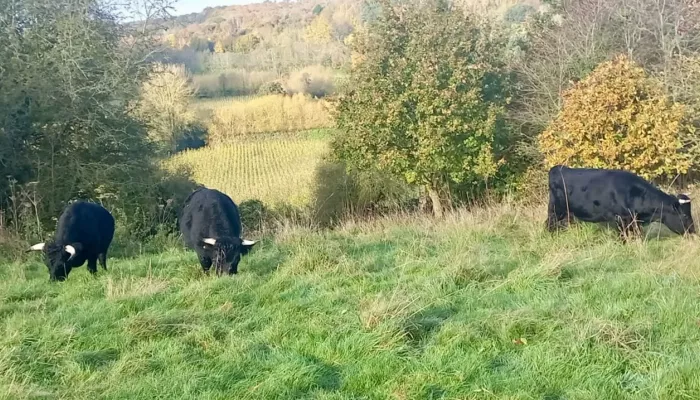Dexters at Golden Hill by National Trust Warden Ranger Iris Roser, cover image by Isaiah Winder
The Dexter is famous for chomping away at thickets of bramble in the Spring, which helps create light and space for other plants to grow. Their small size is ideal on wet woodland sites where they help to maintain the wet edge plants.
At Golden Hill, the cattle will be on site for the next four to six weeks, helping to restore the lowland grassland area and return in Spring for another stint before being moved to another reserve for the summer period.
The release follows on from a successful grazing project partnership between the two charities at Scotney Castle where longhorn and Sussex cattle roam the grounds, helping to manage the land holistically whilst also delighting visitors to the site.
The moment the herd set foot onto their new home was captured on cameras with the event being used as a learning opportunity for the livestock checkers. These volunteers are working through a training programme incorporating site visits, learning about the Trust’s Grazing Plan and Community Engagement strategy and will now go on to help the charity keep a daily watchful eye over the animals.
Kent Wildlife Trust’s Alison Ruyter says:
“The herd seemed impressed with their new surroundings and we are all looking forward to seeing the wildlife benefits that the cattle will bring. The Wilder Grazing Programme is supported by an army of volunteer livestock checkers who are fundamental to the success of the programme. It was great to have a few of them with us to witness the moment the Dexters were released on site.”
Iris Roser, Ranger for National Trust says:
“We’re delighted to be working with Kent Wildlife Trust to help nature’s recovery on this important urban green space.”
Golden Hill was originally bestowed by Queen Elizabeth I to The Canterbury Guardians of the Poor in the 1600s. Later, it came into the hands of Alice-Ethel Redpath, who generously gifted it to the National Trust in 1928. Nearby, Harbledown Mill stood until its demolition in 1913 due to its deteriorating condition; however, the Mill House and the remnants of the old mill's foundations can still be seen today off Mill Lane.
In 1932, the Harbledown Parish Council took over the management of Golden Hill and introduced cattle through a farming tenancy in 1936. Some still refer to it as ‘Cows Meadow,’ with records indicating that cows grazed intermittently in the area until the 1960s. During World War II, the Air Ministry utilized the site for mooring barrage balloons from 1940 to 1945, after which the management was returned to the National Trust.
About livestock checking
Livestock play a huge part in looking after Kent Wildlife Trust’s nature reserves. Their grazing is essential in providing places for our wildlife to live. All of Kent Wildlife Trust’s 800 livestock need checking every day to ensure they are healthy, safe and happy. Full training on how to behave around livestock and what to look out for is provided before taking on this role. To learn more about becoming a volunteer livestock checker click here.

